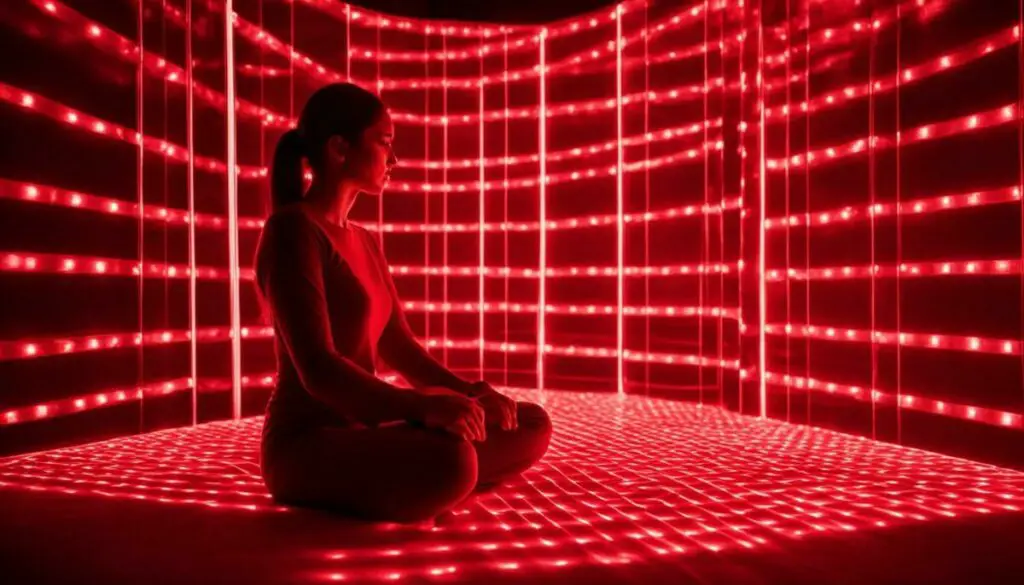Last Updated on 6 months by Francis
When it comes to therapy options, bright light therapy and red light therapy are two popular choices with distinct benefits and applications. While both forms of therapy utilize light, they differ in their focus and target areas. Bright light therapy primarily focuses on regulating mood and sleep patterns, as well as treating seasonal affective disorder (SAD) and depression. In contrast, red light therapy targets cellular processes for healing and skin rejuvenation. With this in mind, it’s important to consider your individual health needs when deciding between these two options.
Contents
Key Takeaways:
- Bright light therapy and red light therapy are two popular forms of therapy that utilize light.
- Bright light therapy primarily focuses on regulating mood and sleep patterns, as well as treating seasonal affective disorder (SAD) and depression.
- Red light therapy targets cellular processes for healing and skin rejuvenation.
- Consider your individual health needs when deciding between these two options.
What is Bright Light Therapy?
Bright light therapy is a treatment method that involves exposure to intense levels of light to alleviate symptoms of various conditions, such as seasonal affective disorder (SAD) and depression. This therapy typically utilizes a lightbox, which emits a bright white light that mimics natural sunlight. The therapy is believed to affect brain chemicals linked to mood and regulate circadian rhythms.
Bright light therapy is a non-invasive and safe method that can be used in the comfort of your own home. It typically involves daily sessions of around 30 minutes to an hour, depending on the individual’s needs. The lightbox is placed at a set distance from the person and is positioned at eye level, allowing the light to enter the retina and activate the necessary brain chemicals.
The benefits of bright light therapy go beyond alleviating symptoms of depression and SAD. Research suggests that it can also help treat sleep disorders, jet lag, and premenstrual syndrome (PMS). It can also improve cognitive function, reducing the risk of dementia and other age-related cognitive decline.

In addition, bright light therapy is a natural form of treatment that does not involve medication or invasive procedures. It is also cost-effective and has minimal side effects, making it an attractive treatment option for many individuals.
How Does Bright Light Therapy Work?
Bright light therapy works by stimulating the retina in the eyes, which sends signals to the brain to adjust the production of certain chemicals, such as melatonin and serotonin. By increasing serotonin levels and reducing melatonin production, bright light therapy can help regulate sleep patterns and improve mood.
Benefits of Bright Light Therapy
Bright light therapy has shown to be highly effective in treating seasonal affective disorder (SAD) and depression. Not only does it help regulate sleep patterns, but it also helps boost mood and energy levels, reducing symptoms of SAD such as lethargy and hopelessness.
Research has also indicated that bright light therapy may improve cognitive function and reduce the severity of symptoms in other mood disorders. The therapy is thought to work by affecting brain chemicals linked to mood and regulating circadian rhythms.
If you suffer from depression or SAD, bright light therapy may be an excellent treatment option for you. Consider speaking with your healthcare professional to see if this therapy is right for you.

How Does Bright Light Therapy Work?
Bright light therapy works by stimulating the retina in the eyes, which sends signals to the brain to adjust the production of certain chemicals, such as melatonin and serotonin. By increasing serotonin levels and reducing melatonin production, bright light therapy can help regulate sleep patterns and improve mood.
The light used in bright light therapy typically mimics natural sunlight and is delivered through a lightbox. The lightbox emits intense levels of light, often ranging from 2,500 to 10,000 lux, which is much brighter than typical indoor lighting. The therapy typically involves sitting in front of the light for 20-30 minutes each day, ideally in the morning, to regulate circadian rhythms.
| Bright Light Therapy Process: |
|---|
| 1. Sit in front of the lightbox for 20-30 minutes each day, ideally in the morning. |
| 2. The intense light mimics natural sunlight and stimulates the retina in the eyes. |
| 3. The brain receives signals to adjust the production of certain chemicals, such as melatonin and serotonin. |
| 4. Increased serotonin levels and reduced melatonin production regulate sleep patterns and improve mood. |
Bright light therapy has been shown to be effective in treating seasonal affective disorder (SAD) and depression. It can also help improve symptoms of other mood disorders and regulate sleep patterns in those with circadian rhythm disorders. Overall, bright light therapy is a safe and effective form of therapy with minimal side effects. However, it’s important to consult with a healthcare professional to determine if bright light therapy is suitable for your individual health needs.

What is Red Light Therapy?
Red light therapy is a non-invasive treatment that uses red or near-infrared light to promote healing and reduce inflammation. This therapy is also known as low-level light therapy or photobiomodulation.
Red light therapy has gained popularity for its ability to promote skin rejuvenation, wound healing, and pain management. The treatment involves exposing the skin to red or near-infrared light, which penetrates the skin and activates specific cellular processes.

One of the primary benefits of red light therapy is its ability to stimulate collagen production, which reduces the appearance of wrinkles and fine lines and improves overall skin texture. Red light therapy also enhances cellular energy production, aiding in tissue repair and reducing inflammation. As a result, it has been used to alleviate pain, accelerate wound healing, and improve the symptoms of certain skin conditions.
Benefits of Red Light Therapy
Red light therapy has numerous benefits for both physical and mental health. Here are some of the key benefits:
- Improves Skin Health: Red light therapy stimulates collagen production, reducing the appearance of wrinkles and fine lines. It also improves skin texture, overall skin tone, and reduces inflammation. It is believed to help improve the symptoms of skin conditions such as acne, rosacea, and eczema.
- Accelerates Wound Healing: Red light therapy increases blood flow to the affected area, promoting faster healing of wounds and injuries. It can also reduce pain and inflammation associated with the injury.
- Reduces Pain and Inflammation: Red light therapy has been shown to alleviate pain associated with conditions such as arthritis, fibromyalgia, and neuropathy. It can also reduce inflammation and swelling.
- Improves Mood and Energy: Red light therapy has been shown to improve mood and energy levels, and may help alleviate symptoms of depression and anxiety.
- Aids in Muscle Recovery: Red light therapy can aid in muscle recovery after exercise, reducing soreness and improving performance.
Overall, red light therapy is a safe and non-invasive treatment with numerous benefits for both physical and mental health.

How Does Red Light Therapy Work?
Red light therapy works by penetrating the skin and activating specific cellular processes. The red or near-infrared light stimulates mitochondria in the cells, increasing ATP (adenosine triphosphate) production. This boost in cellular energy helps promote healing, reduce inflammation, and improve overall skin health.
The wavelengths of light used in red light therapy are absorbed by the skin and tissues, triggering a biological response at the cellular level. When the red or near-infrared light is absorbed by the mitochondria, it promotes the production of ATP, which is the energy source that powers cells. This increase in energy production helps accelerate the healing process and reduce inflammation in the body, making red light therapy an effective treatment for a range of conditions.
In addition to its cellular benefits, red light therapy also stimulates collagen production in the skin. Collagen is a protein that provides structure and elasticity to the skin. As we age, collagen production decreases, leading to wrinkles and sagging skin. Red light therapy can help reverse this process by stimulating collagen production, reducing the appearance of fine lines and wrinkles, and improving overall skin texture.
Red light therapy can also be used to alleviate pain, accelerate wound healing, and improve the symptoms of certain skin conditions, such as acne and psoriasis. Its non-invasive nature and lack of side effects make it a safe and effective treatment option for many individuals.

Differences Between Bright Light Therapy and Red Light Therapy
While both bright light therapy and red light therapy utilize light as a form of treatment, they have distinct differences.
Bright light therapy primarily focuses on regulating mood and sleep patterns, while red light therapy targets cellular processes for healing and skin rejuvenation.
Bright light therapy primarily uses a lightbox that emits bright white light, mimicking natural sunlight, while red light therapy specifically uses red or near-infrared light. Red light therapy is commonly used for skin rejuvenation, wound healing, pain management, and to improve overall skin health. In contrast, bright light therapy has been shown to be effective in treating seasonal affective disorder (SAD) and depression.
While both therapies offer unique benefits, it’s important to consider your specific health needs when choosing between them. Consulting with a healthcare professional can help determine which therapy will best suit your individual needs.

Which Therapy is Best for Seasonal Affective Disorder?
Seasonal affective disorder (SAD) is a type of depression that occurs during the winter months when natural sunlight is scarce. Symptoms include feelings of hopelessness, lethargy, and social withdrawal. As a result, therapy that targets the underlying causes of SAD can be highly effective in reducing its symptoms.
Bright light therapy is considered the best therapy for seasonal affective disorder. It works by regulating circadian rhythms and increasing serotonin levels, which improves mood and reduces symptoms of SAD. Research has shown that bright light therapy is effective in treating depression as well.
Red light therapy is not specifically designed to treat SAD and may not provide the same benefits as bright light therapy in treating this specific condition. However, it has been shown to improve overall mood and energy levels, which may be helpful for individuals with mild SAD symptoms.

Overall, bright light therapy is the gold standard for treating seasonal affective disorder. If you’re experiencing symptoms of SAD, it’s important to consult with your healthcare provider to determine the best treatment plan for your individual needs.
Choosing the Right Therapy for Your Needs
Deciding between bright light therapy and red light therapy depends on your individual health needs. If you’re looking to address symptoms of depression, seasonal affective disorder, or regulate sleep patterns, bright light therapy may be the better choice. With its ability to regulate circadian rhythms and increase serotonin levels, bright light therapy has been shown to effectively alleviate symptoms of seasonal affective disorder (SAD) and depression.
On the other hand, if you’re aiming for skin rejuvenation, wound healing, and pain management, red light therapy may offer more targeted benefits. Its ability to stimulate collagen production and enhance cellular energy production can help reduce the appearance of wrinkles and fine lines and improve overall skin texture. Red light therapy has also been used to alleviate pain, accelerate wound healing, and improve the symptoms of certain skin conditions.
Consulting with a healthcare professional can help determine which therapy best suits your individual needs. They can provide guidance and assess your condition to ensure optimal results.

Conclusion
As we’ve explored in this article, both bright light therapy and red light therapy offer a range of benefits for different health conditions. Bright light therapy is the gold standard for treating seasonal affective disorder and regulating sleep patterns, while red light therapy is often used for skin rejuvenation, wound healing, and pain management.
When considering which therapy to choose, it’s important to consult with a healthcare professional to determine the best fit for your individual needs. Both therapies have their respective strengths and can be used in conjunction with other treatments to maximize their benefits.
Whether you choose bright light therapy, red light therapy, or a combination of both, rest assured that these therapies have been studied and shown to be effective in promoting overall health and wellness.
Still unsure?
Don’t hesitate to reach out to a healthcare professional if you have any questions or concerns about bright light therapy vs red light therapy. Their expertise can help you make an informed decision and determine the therapy that’s right for you.
Remember, your health and wellness are valuable, and taking the time to invest in them is worth it in the long run.
FAQ
What is bright light therapy?
Bright light therapy is a treatment method that involves exposure to intense levels of light to alleviate symptoms of various conditions, such as seasonal affective disorder (SAD) and depression. It typically utilizes a lightbox that emits a bright white light mimicking natural sunlight.
What are the benefits of bright light therapy?
Bright light therapy has been shown to effectively treat seasonal affective disorder (SAD) and depression. It helps regulate sleep patterns, boosts mood and energy levels, and reduces symptoms of SAD, such as lethargy and hopelessness. Research also suggests it may improve cognitive function and reduce the severity of symptoms in other mood disorders.
How does bright light therapy work?
Bright light therapy stimulates the retina in the eyes, sending signals to the brain to adjust the production of certain chemicals, such as melatonin and serotonin. By increasing serotonin levels and reducing melatonin production, it helps regulate sleep patterns and improve mood.
What is red light therapy?
Red light therapy, also known as low-level light therapy or photobiomodulation, is a non-invasive treatment that uses red or near-infrared light to promote healing and reduce inflammation. It is commonly used for skin rejuvenation, wound healing, pain management, and improving overall skin health.
What are the benefits of red light therapy?
Red light therapy stimulates collagen production, reducing the appearance of wrinkles and fine lines and improving overall skin texture. It enhances cellular energy production, aiding in tissue repair and reducing inflammation. It has also been used to alleviate pain, accelerate wound healing, and improve the symptoms of certain skin conditions.
How does red light therapy work?
Red light therapy penetrates the skin and activates specific cellular processes. The red or near-infrared light stimulates mitochondria in the cells, increasing ATP (adenosine triphosphate) production. This boost in cellular energy helps promote healing, reduce inflammation, and improve overall skin health.
What are the differences between bright light therapy and red light therapy?
Bright light therapy primarily focuses on regulating mood and sleep patterns, while red light therapy targets cellular processes for healing and skin rejuvenation. Bright light therapy uses white light, while red light therapy specifically uses red or near-infrared light.
Which therapy is best for seasonal affective disorder?
Bright light therapy is considered the gold standard for treating seasonal affective disorder (SAD). Its ability to regulate circadian rhythms and increase serotonin levels has been shown to effectively alleviate symptoms of SAD. Red light therapy may not provide the same benefits in treating this specific condition.
How do I choose the right therapy for my needs?
When deciding between bright light therapy and red light therapy, consider your specific health needs. If you want to address symptoms of depression, seasonal affective disorder, or regulate sleep patterns, bright light therapy may be the better choice. For skin rejuvenation, wound healing, and pain management, red light therapy may offer more targeted benefits. Consulting with a healthcare professional can help determine the most suitable therapy for your individual needs.








